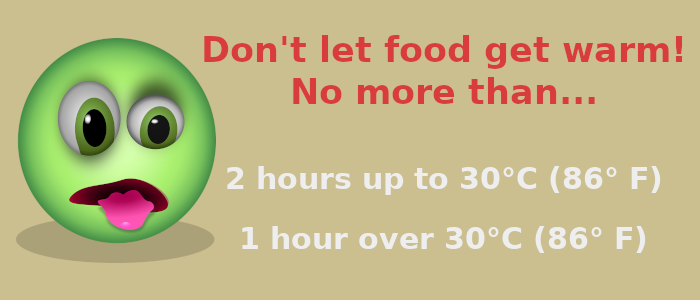Whether we are talking about large refrigeration units or a light and portable camper's chiller, the goal is to suppress the growth of bacteria in food. FDA guidance tell us that the main bacteria we must deal with are e. coli, botulism, salmonella, campylobacter, and listeria. There are also foodbourne viruses which can be troublesome too: novovirus and hepatitus A. Yet a third category of unwanted life in your food are molds, which can be made less active by keeping food cold.
How does my chiller or refrigerator work? By design, a refrigerator or chiller cools the air within it by absorbing its heat, which comes from the heat in food items. A powered refrigerator contains a coolant substance, which actually absorbs heat, changes from a liquid to a gas, and carries heat to a radiator section. There, heat is absorbed by the surrounding air and the coolant goes back to work as a liquid. In the case of a dry-ice unit, absorbed heat from food changes the dry ice into a gas, which is allowed to diffuse out into the surrounding air.
How cold does a refrigerator need to be? It should cool food to just slightly above freezing, generally between 4° C / 39° F degrees and just above freezing. In that range, bacteria are not very active and delicate foods are not damaged by sub-freezing temperature.

Freezers are different, with the goal of keeping food substantially colder than a refrigerator, but - if possible - not causing the food to be damaged or entombed in a hard layer of ice taken from the ambient moisture. A dood temperature for a freezer is -18° C / 0° F, where bacteria and molds are not active (though they continue to live).
Be careful and limit the exposure of raw seafood, poultry, and other meats to warm temperatures, as bacterial growth will ruin those foods. In the market, they should be kept under refrigeration. Try to keep the time from taking them from the market to putting them in your refrigerator limited to a half hour or less. Don't buy any seafood, meats, or poultry of which have been at room temperature and exposed to the sun and warm weather. Be especially wary if flies or other insects have been able to get on the food.
Which foods are the most at risk from not being kept cold? Meat, poultry, seafood, eggs, produce, and dairy products (milk, butter, cheese, and yogurt) are the foods most ravaged by bacteria when temperatures are not cold.

Limit the time your food is out of refrigeration. Set hard limits for food safety, such as:
- No more than two hours exposure to ambient temperatures above 4° C / 39° F up to 30° C / 86° F.
- No more than one hour exposure to ambient temperatures above 30° C / 86° F.
Safe refrigeration also means you compartmentalize your foods; keep the ready to eat foods separated from the vegetables and fruits. Keep the raw meats and seafood separate from everything else. The idea is to prevent bacteria from jumping to other food in the cooler or refrigerator.
Cooling is sometimes uneven in chillers and refrigerators, so foods should be placed with this in mind. Put delicate fruits and vegetables farther from the colder surfaces or chilled air inlets. Meats should be lower, where the cooler and denser air collects, or right up against the cooling surfaces. If you are using dry ice, for example, put meats next to it, but not strawberries.
Which are the best coolers and refrigerators to use? The answer is a matter of engineering and ergonomics: what is effective at cooling, what cools without using too much power, and what is not too difficult to use in day to day life. In fact, this website is all about the best coolers and refrigerators for real people.
© 2021 - 2025 Chillyfood.com, All Rights Reserved.
Written and curated by FridgeMaster William Jackson
Contact, Privacy Policy and Affiliate Disclosure, XML Sitemap.
This website is reader-supported. As an Amazon affiliate, I earn from qualifying purchases.